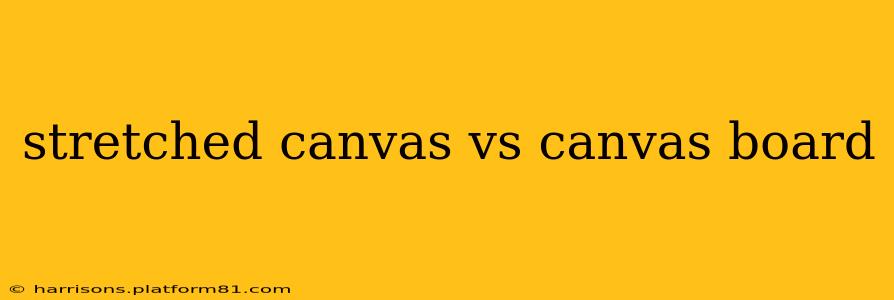Choosing the right painting surface can significantly impact your artistic process and the longevity of your artwork. Two popular choices are stretched canvas and canvas board. While both offer a canvas texture for painting, they have key differences that make them suitable for different purposes and skill levels. This guide will delve into the pros and cons of each to help you make an informed decision.
What is a Stretched Canvas?
A stretched canvas consists of a linen or cotton canvas fabric stretched taut over a wooden frame. The fabric is secured to the frame using staples or tacks, creating a rigid, ready-to-paint surface. Stretched canvases are available in a variety of sizes and depths (the thickness of the frame). Deeper frames offer more support for impasto techniques (thick applications of paint).
Advantages of Stretched Canvas:
- Professional Look: Stretched canvases provide a professional, gallery-ready presentation.
- Versatility: Suitable for a wide range of painting techniques, including wet-on-wet, impasto, and layering. The flexibility of the fabric allows for greater texture manipulation.
- Durability: With proper care, stretched canvases can last for many years.
- Re-usability: If properly primed, canvases can be painted over multiple times.
Disadvantages of Stretched Canvas:
- Cost: Generally more expensive than canvas boards.
- Storage: Requires more storage space due to their bulkier size.
- Potential for Damage: More susceptible to damage from moisture or rough handling if not properly cared for. They can warp if exposed to extreme humidity or temperature changes.
What is a Canvas Board?
A canvas board is a thin canvas fabric glued to a stiff board, typically made of cardboard or hardboard. This creates a flat, rigid painting surface. They are readily available in a variety of sizes and are often less expensive than stretched canvases.
Advantages of Canvas Board:
- Affordability: Significantly cheaper than stretched canvases, making them ideal for practice or beginners.
- Portability: Lightweight and easy to transport, making them suitable for plein air painting.
- Easy to Store: Compact and require less storage space.
- Less Susceptible to Damage: Less prone to warping than stretched canvases.
Disadvantages of Canvas Board:
- Limited Versatility: Not ideal for impasto techniques or heavy layering, as the thin canvas can buckle under the weight of thick paint.
- Less Professional Look: Often perceived as less professional than stretched canvases. The edges are generally not finished and need to be painted or masked for a more polished look.
- Not Reusable: Once the paint is dry it’s usually difficult to reuse the canvas board.
Stretched Canvas vs. Canvas Board: Which is Right for You?
The best choice depends on your individual needs and preferences:
- Beginners: Canvas boards are a great starting point due to their affordability and ease of use.
- Experienced Artists: Stretched canvases offer greater versatility and a professional finish.
- Impasto Techniques: Stretched canvases are preferred for their ability to handle thick paint applications.
- Plein Air Painting: Canvas boards are more portable and convenient.
- Budget: Canvas boards are significantly more economical.
How to Choose the Right Size?
Both stretched canvases and canvas boards come in a wide variety of sizes. Consider the subject of your painting and your desired composition. Larger canvases allow for more detail and expansive scenes, while smaller canvases are better suited for more intimate subjects.
What is the best primer to use on a stretched canvas or canvas board?
Priming your canvas is crucial, regardless of whether you’re using a stretched canvas or a canvas board. Acrylic gesso is a widely used and effective primer, providing an excellent surface for acrylics and oils. It also helps to seal the canvas and prevent the absorption of paint, ensuring better color vibrancy and longevity. Other options include oil primers, but acrylic gesso is typically preferred for its versatility and ease of use.
Can I stretch my own canvas?
Yes, you can stretch your own canvas if you wish to have more control over the canvas material and size. It requires some basic materials and a bit of skill, but it can be a rewarding process. Many tutorials are available online to guide you through this process.
Can I paint on both sides of a stretched canvas?
While technically possible, painting on both sides of a stretched canvas is generally not recommended, especially for oil paints. The weight of the paint could cause the canvas to warp or buckle. If you need to use both sides, consider using a thinner application of paint on each side.
By carefully considering these factors, you can confidently select the painting surface that best suits your artistic vision and skill level. Remember, the most important thing is to choose a surface that inspires you to create!
